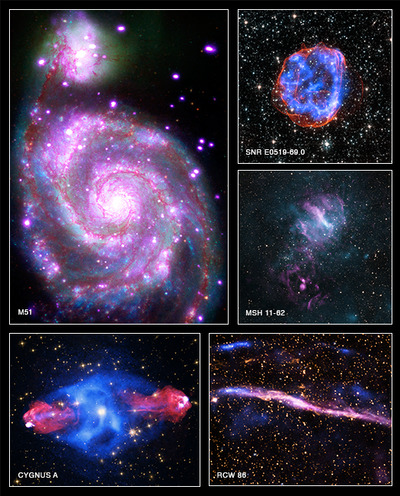 |
To celebrate the International Year of Light, five Chandra images (M51, SNR E0519-69.0, MSH 11-62, Cygnus A, and RCW 86) have been released.
Image Credit: NASA/CXC/SA |
| |
London, the UK – December 06, 2015
The Space Innovation Congress is a Space Technology Conference and Exhibition, taking place in London on 7-8 April 2016.
7th - 8th April 2016, St Paul's, 200 Aldersgate, London, the UK.
It is set to showcase the most cutting edge technologies and uses of Space Technology providing insight from over 50 speakers sharing their unparalleled industry knowledge and real-life experiences.
This year’s Space Innovation Congress will be highlighting the most innovative advancements in Space technology and will look at how these are being applied to many industry verticals from farming to banking, and the practical case studies that are coming out of these projects.
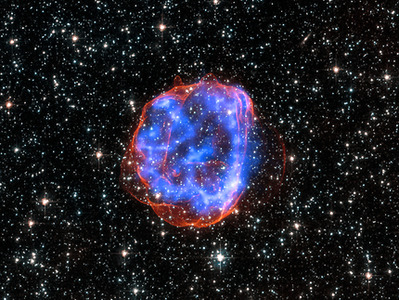 |
Chandra Celebrates the International Year of Light.
Image Credit: NASA/CXC/SAO |
| |
With user cases with dedicated tracks covering the entire Space exploration and Earth observation ecosystems: Satellites, Big data, Crop monitoring, Space debris, Maritime surveillance, Space weather and its impact on banking systems, Biomedical, Commercial space collaboration and Telecoms.
Experience two days of discussion, exploration, in-depth analysis and high level networking at Space Innovation Congress this year.
 |
| Photo courtesy of the Space Innovation Congress |
| |
Come along with a free expo only pass and see first hand a showcase of the most exciting space technology.
http://booking.spaceinnovationcongress.com/expo
Purchase a Conference ticket that will give you access to both conference and exhibition, be inspired by the talks on offer, participate in the panel debates and network with your peers.
http://booking.spaceinnovationcongress.com/
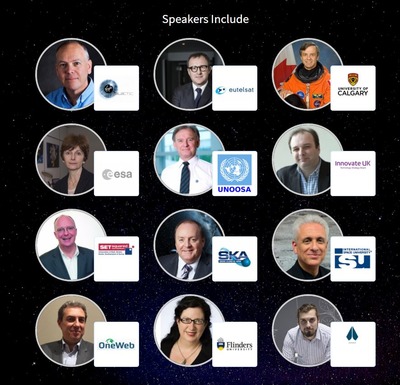 |
| Photo courtesy of the Space Innovation Congress |
| |
Don’t miss your opportunity to join us by registering today!
http://www.spaceinnovationcongress.com/
Agenda
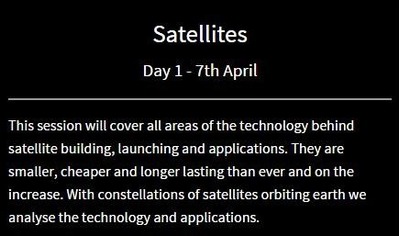 |
| Courtesy of the Space Innovation Congress |
| |
Day 1 – Track 1
Satellites, Earth Observation and Navigation
7 April 2016
This session will cover all areas of the technology behind satellite building, launching and applications.
Satellites are smaller, cheaper and longer lasting than ever and on the increase.
Constellations of satellites orbiting earth here we analyse the technology that enables it to be so.
09:45AM
Nano, micro and pico satellites
Nano, micro and pico satellites have been on the increase over the last few years.
Small satellites have recorded data on the terrestrial and space environment near the moon and Earth, helped in the search for planets on other star systems, and demonstrated various telecommunications systems that we enjoy today.
These satellites have served as test beds for the development of new space technologies, and as hands-on educational tools for countless students, scientists, and engineers.
In this session you will find our the latest development and game changers in small satellites development and what this may mean for our future.
10:15AM
Satellite capacity in orbit
Since the birth of commercial satellite systems in the 1960s, satellites have grown to deliver a broad range of essential services to people around the globe.
They are a key element in delivering television broadcasting and mobile networks infrastructure, in providing emergency telecommunications, global positioning, meteorological information, environmental monitoring, and communication services that ensure safety of life on land, at sea and in the sky.
The development of satellite communication has highlighted the need for managing a new, previously unused, international resource – the satellite spectrum/orbit resource.
Due to the growing demand for satellite capacity, this resource – particularly the geostationary-satellite orbit (GSO), which supports a large part of the world’s TV, live global broadcast and data services (VSAT and mobile networks backhaul) – is becoming increasingly crowded. At the same time, the increasing use of lower Earth orbits is further increasing the need for international coordination.
In this session we will focus on the satellite capacity in orbit, its challenges and solutions.
10:45AM
networking break
11:15AM
Data from satellite constellations
Today satellites perform functions that are taken for granted. It seems sufficient to think about international telecommunications, navigation, weather forecasts and earth monitoring.
Until a few years ago, large and expensive satellites, operated by government agencies, performed all of these functions.
Recently, the same functions performed by a 5 ton satellite at a cost of hundreds of millions of dollars and several years of development, can be effected by specialized small satellites of some tens of kilograms, even developed in one year and with a cost of few millions dollars.
The main benefits of this trend center around the cost, the replacement technology, the quicker data update and, above all, the possibility for other opportunities to look out into space and use it.
In this panel session we will look into how data from satellite constellations is accessed, processed and delivered.
Read more about it here:
http://bit.ly/1FLnQFS
Helena Correia Mendonça, Managing Associate, Vieira de Almeida
Giovanni Pandolfi, CTO, Leaf Space.
12:00AM
Keynote – Public and private partnerships in satcom industries
Magali Vaissiere, Director of Telecommunications and integrated Applications at the European Space Agency will address the public and private partnerships in the satcom industries.
This session will address how communication satellites are changing the game in suborbital rockets, innovative small satellites, partnerships with commercial efforts and “mainstream” science missions in the
EELV/Falcon 9/Delta II/Taurus II ranges.
Magali Vaissiere, Director of Telecommunications and Integrated Applications , European Space Agency.
12:30PM
Lunch
 |
| Photo courtesy of the Space Innovation Congress |
| |
Earth observation and navigation from space – Day 1
01:30PM
Science, technology and applications
According to the OECD, there are currently more than 100 EO programmes run by civilian space agencies. Satellite numbers continue to increase as different countries and regions compete in this strategically important sector, in which the United States, Europe, China and India are the biggest players.
Many of the national players are also collaborating on the Global Earth Observation System of Systems (GEOSS) – an international infrastructure for sharing and disseminating EO data.
It is accepted and proven that Earth observation information gathered from spacecraft provides substantial benefits supporting economic development and supports informed policy and decision making.
In this session we look into the science, technology and applications of EO programmes with some of the best known players in this market.
02:00PM
Earth observation for weather prediction
Satellites scan the globe day and night, sending back an endless stream of information about the atmosphere, ocean, land, and space such as temperatures, cloud formations, wind patterns, and sea currents.
Accurate forecasts and severe weather alerts on television and radio, on web pages, and smart phone “apps” all rely on this satellite driven information.
They also are critical to monitoring and predicting environmental events such as El Niño and La Niña, coral bleaching, ocean acidification, and algal blooms.
In this session we will focus on short-term and long-term weather forecasting, atmospheric and oceanic research, and the technology is used to guard nations from unexpected severe weather such as hurricanes, winter storms, and even solar storms.
02:30PM
Networking break
03:00PM
Space weather effect on banking systems
Sitting at the center of our solar system, the sun is a huge thermo-nuclear reactor, fusing hydrogen atoms into helium and producing million degree temperatures and intense magnetic fields.
As a result, the sun is regularly bathing Earth and the rest of the solar system in a wash of energy in the forms of light, electrically charged particles, electrons and magnetic fields.
Space weather phenomena is much influenced by an 11-year cycle of solar activity.
At the maximum of the solar cycle, violent events are common on the Sun.
When those events eject solar matter and energy towards the Earth they produce space weather phenomena, such as intense magnetic and radiation storms.
Streams of charged particles during geomagnetic storms can create changes in the ionosphere that can disrupt the use of high frequency radios used for search and rescue, the Global Positioning System (GPS), and even ground/air communications within the aviation industry.
The banking industry increasing dependency on reliable and round the clock technology systems, often provided by Global Navigation Satellite Systems (GNSS) of which the best-known is the American GPS, are commonly used for deriving time stamps for financial transactions.
Precision in timing is therefore critical, in particular for high-speed trading.
Awareness among operators and regulators worldwide is currently limited and resilience across the financial services sector needs to be built.
In this session we will detail the risks and how to mitigate them.
Read more about it here:
http://bit.ly/1LvWIZp
Neil Mitchison, (former) Head of the "Security Technology Assessment", European Commission.
03:30PM
Maritime surveillance from space
Maritime security is of utmost importance today with more than 90% of the world’s trade goods and more than 70% of global crude oil transported by sea.
As shipping traffic grows, the pressure on the security of the world’s oceans is increasing: not only is there more likelihood of accidents and associated environmental damage, shipping traffic is also increasingly the target of piracy, organised crime and terrorism.
Moreover, illegal maritime activities such as illegal fishing, drug trafficking, weapon movement/proliferation and illegal immigration are constantly on the rise.
Maritime activities are also expanding into the Arctic regions with growing traffic in the ice-infested waters of the Northeast and Northwest Passage, and oil and gas platforms set up to exploit the huge reservoirs of resources in the Arctic.
These activities rely on detailed and timely ice information to support safe and effective operations.
In this session we will explore how the data from constellations of radar and optical satellites can provide a accurate and round the clock maritime surveillance.
04:00PM
Vulnerability of GPS systems
GPS provides free of charge precise time and position information worldwide.
In a world of instant communications, much of our global telecom infrastructure relies on GPS to provide precise time and frequency information.
For instance, telephone companies take advantage of GPS to synchronize their global telecom networks with inexpensive timing receivers.
But despite how much we rely on the Global Positioning System (GPS) for position information and as a time (and hence frequency) base, GPS remains vulnerable to natural and man-made obstacles.
From receivers in poor geographic locations, to lost satellite signals, to jammed reception, GPS has at times been sensitive to interruptions.
In this session we will focus on the vulnerabilities of GPS systems and the Galileo programme.
Galileo is to provide an indigenous alternative high-precision positioning system upon which European nations can rely, independently from the Russian GLONASS and US GPS systems, in case they were disabled by their operators.
The use of basic (low-precision) Galileo services will be free and open to everyone.
The high-precision capabilities will be available for paying commercial users.
Galileo is intended to provide horizontal and vertical position measurements within 1-metre precision, and better positioning services at high latitudes than other positioning systems.
04:45PM
Networking drinks
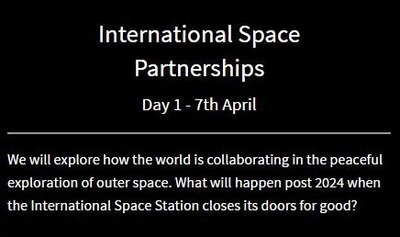 |
| Courtesy of the Space Innovation Congress |
| |
Day 1 – Track 2
Partnerships and Technology
7 April 2016
09:00AM
Keynote – The Politics of Space
The Politics of Space keynote address will open the Space Innovation Congress with a global contextualisation of the evolution of the space industry since the Moon landing.
We are seeing growing investment in space ready technology, the launch of the European Copernicus and Galileu programmes and commercially viable private companies competing in this ecosystem.
Dr Jill Stuart’s interview for the London School of Economics:
http://bit.ly/XHxIxB
Dr Jill Stuart, Space Politics Specialist & Fellow in Global Politics in the Department of Government at the London School of Economics, LSE.
09:30AM
Innovation Incubator
Innovation Incubator at the Space Innovation Congress, sponsored by Set Squared, will showcase the top 20 applicants in downstream satellites applications, EGNSS, Earth Observation, Big data.
Here we will introduce the Entrepreneurship Programme and SETsquared’s Space Accelerator Hub as well as the companies that have made it to the final 20.
Innovation Incubator aims to support start-ups and companies up to a year to go from idea stage to market ready with mentoring, grants and R&D.
Simon Bond, Innovation Director, Set Squared.
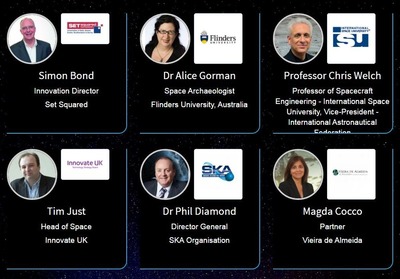 |
| Photo courtesy of the Space Innovation Congress |
| |
International space partnerships – day 1
International Space Partnerships session, chaired by Professor Chris Welch, VP International Astronautical Federation will address international collaboration between nations, companies and space programmes for peaceful uses of outer space.
09:45AM
Global internet access from space
Global internet access from space is set to become a reality as early as 2019.
With several companies in the running to reach hundreds of millions of potential users residing in places without reliable broadband access via satellite constellations.
These will operate in circular low Earth orbit providing full and consistent coverage across the globe.
This session aims to analyse these plans and its implications, the benefits for a connected planet and the onus on a already congested orbit.
Tony Azzarelli, VP Regulatory Affairs, OneWeb.
10:15AM
International space cooperation
International space cooperation will be called upon more than ever post closure of the International Space Station in 2024.
Within the next 10 years, we will see the transition from government-run International Space Station to privately built and operated facilities.
With NASA saying it will not build another space station in low-earth orbit instead, it will look to buy services from the private sector.
In this session we will look what this means for the space ecosystem, who are the big players entering the market and their plans.
10:30AM
Networking break
11:15AM
Satellite technologies in emerging economies
Satellite technologies in emerging economies session will detail the benefits of space technologies in domestic economic growth, international partnerships and a digital global economy.
This panel will analyse the ‘African Union Space Policy’ and ‘African Union Space Strategy’ implications for the member nations and the global space technology suppliers.
Magda Cocco, Partner, Vieira de Almeida.
12:00AM
Keynote – European space policy
The formal European Space Policy was established on 22 May 2007, jointly drafted between the European Commission and the Director General of the European Space Agency.
In this sessions we will focus mainly on the autonomous, multi-level operational Earth observation capacity of the Copernicus programme.
http://www.copernicus.eu
We will also look into the Galileo global navigation satellite system and what it will mean in terms of an European independent GPS system.
http://www.gsa.europa.eu
12:15PM
Lunch
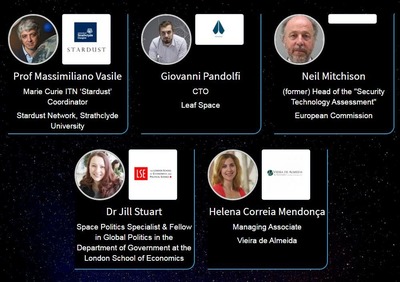 |
| Photo courtesy of the Space Innovation Congress |
| |
Space technology – day 1
01:30PM
Advanced propulsion
Breakthroughs in advanced propulsion systems can significantly improve space mission performance well beyond what can be achieved with today’s conventional systems.
The main benefits would include improvements in overall mission delta-v manoeuvre capability and the enabling of entirely new missions or space transportation architectures.
To further explore our solar system, faster trip times, substantial increase in payload mass delivery, or a large reduction in overall spacecraft mass/size is needed.
In this session we will explore some of the innovators in this field, their manufacturing expertise and technology concepts.
02:00PM
Nanocoatings
Nanocoatings technology is set to drive down the cost of satellites.
These are flexible layers structures that are elastic, stand great stress and enormous changes in temperatures.
In this session we will focus on these microstructures and what they will mean for the space industry.
02:30PM
Networking break
03:00PM
Energy storage in space
In this session we will look at the innovations in energy storage in space.
With every pound of payload sent into space costing around €9,000, lighter and effective ways to store energy is orbit is key for commercially viable cost, effective solutions.
Ultracapacitor technology has the potential to increase mission safety while reducing mission costs.
03:30PM
Radiation hardened electronics
Space radiation affects all spacecraft and electronics have a long history of power resets, safing, and system failures due to long duration exposures, unpredictable solar proton activity and ambient galactic cosmic ray environment.
Three approaches may be employed (independently or in combination) to protect electronic systems in the radiation environment:
• Shielding
• Commercial parts in redundant and duplicative configurations
• Electronics hardened for radiation and environmental exposure
In this session we will focus on radiation hardened electronics, so that systems become resistant to damage or malfunctions caused by ionizing radiation (particle radiation and high-energyelectromagnetic radiation).
04:00PM
Life expectancy of orbital instruments
Panel discussion on new technology to prolong the life expectancy of orbital instruments – from coatings to energy storage, to lighter payloads and faster journey times.
04:45PM
Networking drinks
 |
| Courtesy of the Space Innovation Congress |
| |
Day 2 – Track 1
Big data and space debris
8 April 2016
09:00AM
Keynote – Peaceful uses of outer space
Space science and space applications advance our knowledge of the universe.
They also improve the daily lives of people worldwide through their contributions to environmental monitoring, management of natural resources, meteorological forecasting, climate modelling, satellite navigation, communications, and early warning systems to help mitigate potential disasters.
If the international community wishes to increase access to the benefits of current space applications, and develop new technologies which may offer further benefits, there is a need to preserve and protect the outer space environment for use by future generations.
Space activities need to be sustainable over the long term.
Throughout the years, the Committee on the Peaceful Uses of Outer Space has considered different aspects of the long-term sustainability of outer space activities identifying areas of concern for the long-term sustainability of outer space activities, proposing measures that could enhance sustainability, and producing voluntary guidelines to reduce risks to long-term sustainability.
It has addressed thematic areas including sustainable space utilization supporting sustainable development on Earth; space debris, space operations and tools to support collaborative space situational awareness; space weather; and regulatory regimes and guidance for actors in the space arena.
Dr David Kendall, Chair, UN COPUOS, 2016-17.
09:30AM
Space data in the cloud
In this session we will focus on space data and its access to the
‘European Open Science Cloud’
This is perceived as a sustainable infrastructure for the management and long-term stewardship of research data, with the final aim to accelerate discovery and innovation.
Science in Europe should be supported by the infrastructure and it should make existing data infrastructures in different domains more interoperable.
The infrastructure should obviously be placed in global context. Also, it will have to support controlled access to data where this is needed for reasons of privacy or data protection.
10:00AM
SKA – the largest space data project in the world
In 2018, a group of organizations from all of the world will begin construction of the largest radio telescope ever built, the Square Kilometre Array (SKA).
https://www.skatelescope.org
With one million square meters of collecting area and enough optical fiber to wrap around the Earth twice, this marvel of modern engineering will be sensitive enough to detect airport radar on a planet 50 light years away.
SKA will also generate 700 terabytes of data every second, equivalent to roughly 35 times the data stored in the Library of Congress.
At full capacity, the SKA’s aperture arrays are expected to produce 100 times more data than the entire Internet. It doesn’t take a rocket scientist to realize that such a deluge of information creates a big data problem, perhaps the biggest we have ever encountered.
Solving this big data problem for the space industry requires innovation in the data storage, processing, and access (or visualization) technologies, which, in turn, creates ample opportunities for startups and large data crunching companies to take advantage of.
Dr Phil Diamond, Director General, SKA Organisation.
10:30AM
Networking break
11:00AM
Big data in space exploration
A few major factors will drive exponential growth in the amount of terabytes falling on us from the skies over the next couple of decades: the increasing speed of commercial satellite deployment, implementation of faster communication technology, and the onset of interplanetary missions.
The dwindling cost of launches and the democratization of the satellite market are going to result in an unprecedented growth of orbital activity. Based on announced plans by various companies and space programs, between 2,000 and 2,750 cube- and nano-sats will be launched by the end of this decade.
Most of the new spacecraft will have commercial applications, particularly in Earth observation.
Earth observation means images and video, often multi-spectral or even 3D, which are some of the heaviest “packages” in terms of data units involved.
Historically, the single largest barrier that has kept the space data floodgates closed was the ability to transmit the collected information back to Earth. Most current space missions use radio frequency to transfer data, which is a relatively slow approach.
NASA’s typical deep space explorer would send back data on the order of megabytes per second, while earth orbiting spacecraft are typically doing so in gigabytes per second.
In the future, however, the space industry is expected to start switching to new type of optical (or laser) communications that will significantly increase the download speed and mean a 1,000-multiple surge in the volume of data.
In this session we will explore the implications of big data in space exploration and showcase what cloud computing technologies can do for the space industry.
11:30AM
Big data – availability, accuracy and processing technologies
In this panel we will debate the availability, accuracy and processing technologies of space big data.
How the concept of sharing economy will develop in the geo-business by mobilizing underused assets — satellite constellations, UAVs, and other aerial imaging platforms — and essentially creating a new revenue channel for data owners.
We will also look into the Copernicus programme and how this will be a game changer to the current ecosystem.
Copernicus consists of a complex set of systems which collect data from multiple sources: earth observation satellites and in situ sensors such as ground stations, airborne and sea-borne sensors.
It processes these data and provides users with reliable and up-to-date information through a set of services related to environmental and security issues.
The services address six thematic areas: land, marine, atmosphere, climate change, emergency management and security.
They support a wide range of applications, including environment protection, management of urban areas, regional and local planning, agriculture, forestry, fisheries, health, transport, climate change, sustainable development, civil protection and tourism.
Mark Rawlins, Director of Communication System Operations, Eutelsat.
12:15PM
Lunch
Space debris and other threats – day 2
01:30PM
Space surveillance and debris mitigation
As we move into a more connected world dependent on satellite information, the rise of small satellites, we will see more and more objects in orbit.
This will create a significant environmental problem as we find a large number of space junk or orbital debris.
Something will need to be done about it before space gets too congested.
Dr Alice Gorman, in this session, will focus on the cultural significance/heritage value of space junk.
Dr Gorman will contribute a cultural-heritage perspective to international agreements on reducing the orbital debris problem.
Watch Dr Gorman’s interview on TEDx Sydney:
http://bit.ly/1XrxasG
Dr Alice Gorman, Space Archaeologist, Flinders University, Australia.
02:00PM
Debris environment modelling
The prediction of the damage, the future evolution of the orbit of debris and asteroids and their response to a deflection/removal attempt require modelling of the dynamics and dynamic environment, the long term simulation, the modelling and simulation of the possible damage including re-entry and impact on ground.
Scientists continue to develop and upgrade orbital debris models to describe and characterize the current and future debris environment.
Engineering models, such as ORDEM 3.0, can be used for debris impact risk assessments for spacecraft and satellites, including the International Space Station and the Space Shuttle.
Whereas, evolutionary models, such as LEGEND, are designed to predict the future debris environment.
They are reliable tools to study how the future debris environment reacts to various mitigation practices.
In this talk, Professor Vasile will introduce this research area that forms the basis of every analysis or tool that aims to predict the evolution of the debris environment, the danger of an actual impact with an asteroid, the consequences of a deflection or removal action.
Prof Massimiliano Vasile, Marie Curie ITN ‘Stardust’ Coordinator, Stardust Network, Strathclyde University.
02:30PM
Networking break
03:00PM
Space debris standardization and policies
The most effective short-term means of reducing the space debris growth rate is through the prevention of in-orbit explosions.
The only effective long-term means of stabilising the space debris environment at a safe level is through the removal of mass (five to ten large objects per year) from regions with high object densities and long orbital lifetimes.
Both types of mitigation measures need to be applied broadly and in a timely manner to avoid uncontrolled growth of the debris environment.
If mitigation concepts are applied insufficiently, or too late, some orbit regions, particularly the valuable 800- to 1400-km altitude, may experience a collisional cascading process that could render these regions too dangerous for space activities within a few decades.
In this session we will focus on the international effort currently being done to minimise space debris.
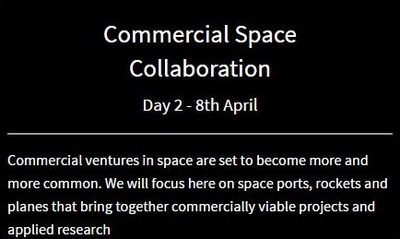 |
| Courtesy of the Space Innovation Congress |
| |
Day 2 – Track 2
Biomedical and Space collaboration
8 April 2016
09:30AM
Space vehicles and technology advances
A space vehicle is a rocket-powered vehicle used to transport unmanned satellites or humans between the Earth’s surface and outer space.
The earliest space vehicles, starting in 1957, consisted of expendable launch systems carrying spacecraft payloads (satellites or human-bearing space capsules) which were relatively small portions of the total vehicle size and mass.
Reusable launch systems have been envisioned since the late 1960s, and are still under development today with several companies worldwide working on ways to have manned or unmanned spacecraft to return safely to Earth.
10:00AM
Commercial ventures in space
In the early decades of the Space Age, the government space agencies of the Soviet Union and United States pioneered space technology in collaboration with affiliated design bureaus in the USSR and private companies in the US.
The European Space Agency was formed in 1975, largely following the same model of space technology development.
Later on, large defense contractors began to develop and operate space launch systems, derived from government rockets.
Private spaceflight in Earth orbit includes communications satellites, satellite television, satellite radio, astronaut transport and sub-orbital and orbital space tourism.
Entrepreneurs have begun designing and deploying competitive space systems to the national-monopoly governmental systems of the early decades of the space age.
Successes to date include flying suborbital spaceplanes, launching orbital rockets, and flying a couple of orbital expandable test modules (Genesis I and II).
10:30AM
Coffee Break
11:00AM
Out of this world and back again
Virgin Galactic is the world’s first commercial spaceline.
Founded by Sir Richard Branson, Virgin Galactic aims to transform access to space.
To date, 700 men and women from over 50 countries – greater than the total number of humans who have ever been to space – have reserved places to fly on Virgin Galactic’s reusable suborbital spaceplane, SpaceShipTwo.
The company is also developing
LauncherOne, an affordable dedicated ride to orbit for small satellites.
As an air-launched rocket,
LauncherOne is designed to provide a flexible launch service for commercial- and government-built satellites that meets each customer’s specific mission requirements.
In his presentation, Jonathan Firth will give an overview of the development and progress of the company, with particular focus on how it assesses and manages risk.
Jonathan Firth, Executive Vice President of Spaceport and Program Development, Virgin Galactic.
11:30AM
Keynote – UK innovation and space policy
The UK has a world class space industry. But for many years, if not decades, this was a ‘hidden success’.
Over time, Britain had considerable success with communications and scientific applications satellites — commercially valuable and technologically advanced, but hardly the most spectacular aspect of space activities.
From the turn of the century, things have changed in several significant ways.
Even if the focus of British space did not greatly change, there has been a growing awareness of the economic and social value of space to the UK and, more important, governments have begun to appreciate this fact.
Public investments have been made in key areas for the future — particularly communications, Earth observation and navigation — and an increased commitment to the European Space Agency (ESA) has much enhanced Britain’s standing in key European programmes.
Tim Just, Head of Space, Innovate UK.
12:15PM
Lunch
01:30PM
Healthcare in space, benefits on earth
This session will explore how medical research conducted on space impacts and accelerates developments on Earth.
Dr Robert Thirsk, Chancellor and former astronaut Canadian Space Agency, University of Calgary.
02:30PM
Bacteria in space
From fungi and bacteria currently growing in the International Space Station to bacteria as a potential energy source in space.
The microbes, capable of producing sugar, could possibly provide food, fuel, and even medicine for travelers on a long space voyage.
03:00PM
Coffee Break
03:30PM
Lessons from zero gravity
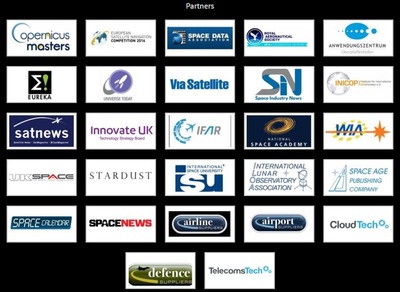 |
| Photo courtesy of the Space Innovation Congress |
| |
Contact Us
Space Innovation Congress is the showcase event for space related technology.
Whether you are a manufacturer, researcher, vendor, industry leader, developer or cutting edge technology start up the Space Innovation Congress provides a unparalleled platform to showcase your technology and services to an audience including developers operators, technology providers, industry leaders, funders, innovators and vendors.
We have a variety of ways to get involved from exhibiting and sponsored speaking to branding opportunities and sponsorship of our tracks and different areas of the show.
For more information, or to discuss the best options for your company, please get in touch using the contact details below.
Speak to the team…
rita.andrews@spaceinnovationcongress.com
+44 (0) 7818075418
5 Bramley Road, Street, Somerset BA16 0QE
Source: Space Innovation Congress
http://www.spaceinnovationcongress.com/
ASTROMAN Magazine - 2015.10.02
Flight VA226 success: with Sky Muster and ARSAT-2 in orbit, Arianespace serves Australia and Argentina
http://www.astroman.com.pl/index.php?mod=magazine&a=read&id=1972
ASTROMAN Magazine - 2015.07.26
Airbus Defence and Space to build JUICE spacecraft, ESA's next life-tracker inside the Solar System
http://www.astroman.com.pl/index.php?mod=magazine&a=read&id=1941
ASTROMAN Magazine - 2015.07.18
Boeing's 10th GPS IIF to Modernize Worldwide GPS System
http://www.astroman.com.pl/index.php?mod=magazine&a=read&id=1940
ASTROMAN Magazine - 2015.06.14
Boeing to Build Third All-Electric Propulsion Satellite for ABS to Australia, New Zealand, the Middle East, Russia, South Asia
http://www.astroman.com.pl/index.php?mod=magazine&a=read&id=1929
ASTROMAN Magazine - 2015.02.14
ESA experimental the IXV spaceplane completes research flight
http://www.astroman.com.pl/index.php?mod=magazine&a=read&id=1871
ASTROMAN Magazine - 2015.01.24
NASA: Chandra Celebrates the International Year of Light
http://www.astroman.com.pl/index.php?mod=magazine&a=read&id=1865
ASTROMAN Magazine - 2014.12.20
Lockheed Martin-Built MUOS-3 Secure Communications Satellite Encapsulated in Launch Vehicle Fairing
http://www.astroman.com.pl/index.php?mod=magazine&a=read&id=1849
ASTROMAN Magazine - 2014.11.09
U.S. Navy and Lockheed Martin Deliver Third MUOS Secure Communications Satellite for Mobile Warfighters
http://www.astroman.com.pl/index.php?mod=magazine&a=read&id=1825
ASTROMAN Magazine - 2014.10.18
Boeing-built X-37B Orbital Test Vehicle Successfully Completes 3rd Flight
http://www.astroman.com.pl/index.php?mod=magazine&a=read&id=1812
ASTROMAN Magazine - 2014.08.21
Drugi polski satelita naukowy "Heweliusz" już na orbicie
http://www.astroman.com.pl/index.php?mod=magazine&a=read&id=1778
ASTROMAN Magazine - 2014.08.16
Lockheed Martin Commercial Launch Services Successfully Launches WorldView-3 Satellite
http://www.astroman.com.pl/index.php?mod=magazine&a=read&id=1775
ASTROMAN Magazine - 2014.08.09
Boeing Awarded $250 Million Contract to Modernize NATO AWACS Fleet
http://www.astroman.com.pl/index.php?mod=magazine&a=read&id=1771
ASTROMAN Magazine - 2014.05.17
6th Boeing GPS IIF Spacecraft Reaches Orbit, Sends 1st Signals
http://www.astroman.com.pl/index.php?mod=magazine&a=read&id=1714
ASTROMAN Magazine - 2014.04.05
U.S. Air Force Satellite Launched Today Will Improve Weather Prediction By Lockheed Martin
http://www.astroman.com.pl/index.php?mod=magazine&a=read&id=1692
ASTROMAN Magazine - 2014.02.22
5th Boeing GPS IIF Spacecraft Sends Initial Signals from Space
http://www.astroman.com.pl/index.php?mod=magazine&a=read&id=1659
ASTROMAN Magazine – 2013.04.14
Boeing X-48C Blended Wing Body Research Aircraft Completes Flight Testing
http://www.astroman.com.pl/index.php?mod=magazine&a=read&id=1443
ASTROMAN Magazine – 2013.04.02
Boeing to Demonstrate Innovations in Space and Cyberspace at National Symposium
http://www.astroman.com.pl/index.php?mod=magazine&a=read&id=1433
ASTROMAN Magazine – 2012.12.15
Boeing's Reusable, Unmanned X-37B Orbital Test Vehicle Begins 2nd Flight
http://www.astroman.com.pl/index.php?mod=magazine&a=read&id=1366
ASTROMAN Magazine – 2012.10.15
Intelsat Accepts 2nd On-Orbit Boeing 702MP Satellite
http://www.astroman.com.pl/index.php?mod=magazine&a=read&id=1333
ASTROMAN Magazine – 2012.08.09
Boeing Flies X-48C Blended Wing Body Research Aircraft
http://www.astroman.com.pl/index.php?mod=magazine&a=read&id=1292
ASTROMAN Magazine – 2012.06.19
2nd Boeing-built X-37B Orbital Test Vehicle Successfully Completes 1st Flight
http://www.astroman.com.pl/index.php?mod=magazine&a=read&id=1257
ASTROMAN Magazine – 2012.06.08
Boeing, Raytheon and Harris to Pursue GPS Control Segment Sustainment Contract
http://www.astroman.com.pl/index.php?mod=magazine&a=read&id=1252
ASTROMAN Magazine - 2010.11.12
NASA: Glory Mission. Understanding Earth’s Energy Balance
http://www.astroman.com.pl/index.php?mod=magazine&a=read&id=842
Editor-in-Chief of ASTROMAN magazine: Roman Wojtala, PhD.

